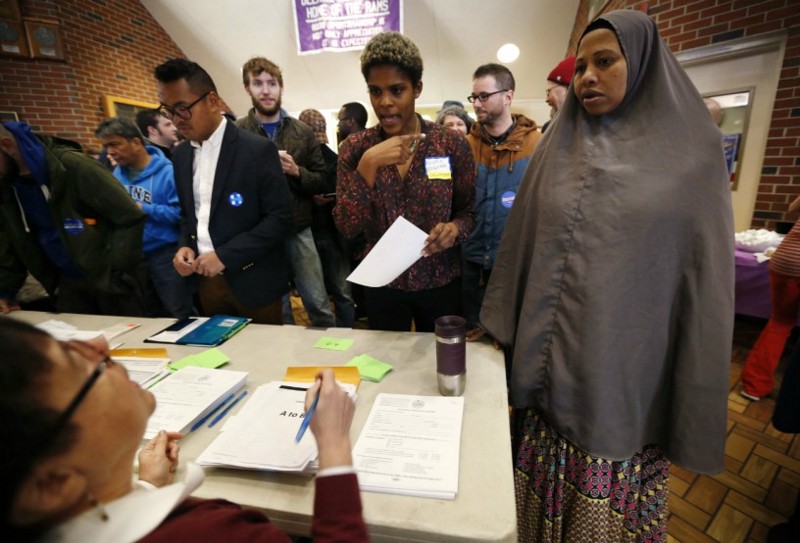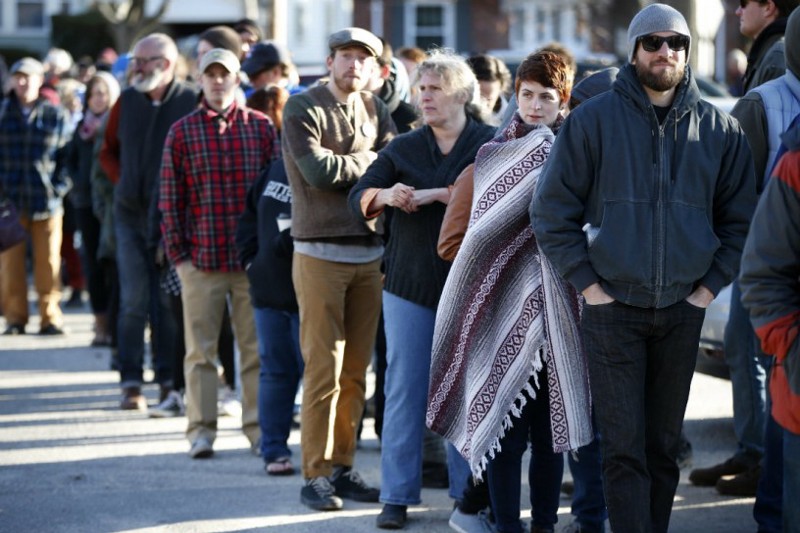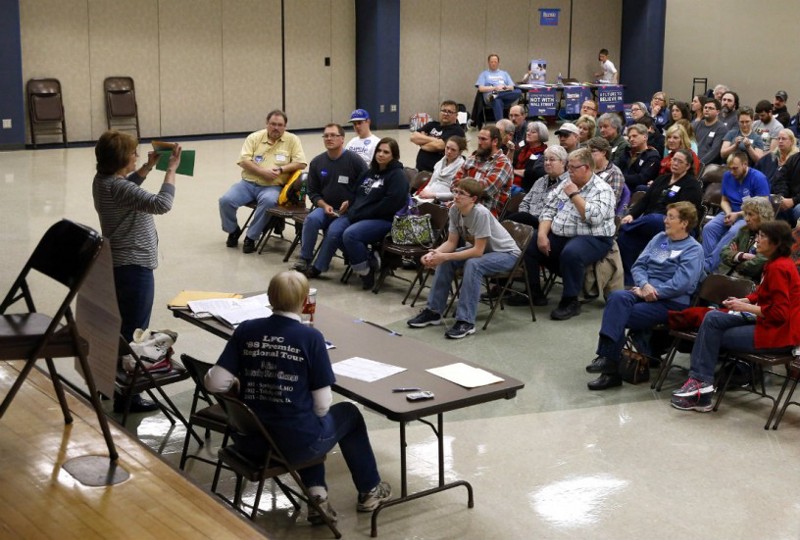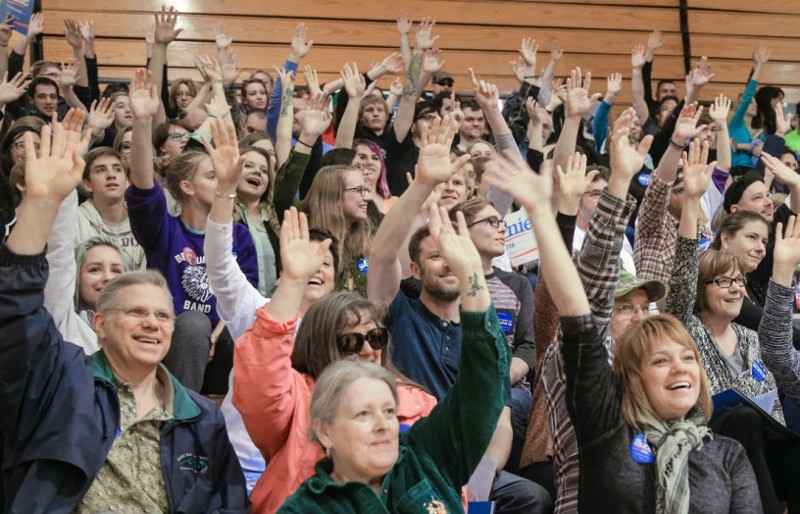Keane Schwartz, a Bernie Sanders supporter, was the lone Democratic voter at his Iowa precinct last month. So it came as somewhat of a surprise when he saw state results list his jurisdiction as having awarded its delegate to Hillary Clinton. “It was really suspicious,” Schwartz told the Des Moines Register. “I’m actually pretty irate about it.”
Others couldn’t even make it to their caucuses. Davenport’s Patricia Diaz had an evening shift at Dillard’s department store and could not afford to take time off, even though she wanted to participate. Criticisms of the presidential nominating caucuses held in states like Nevada, Iowa, Minnesota, and Maine, instead of primaries, are nothing new.
A caucus is a gathering of party members, who meet at a specific time to choose their preferred nominee and handle other party business. In some cases, it’s a secret ballot. In others, voters have to share their choice with their neighbors.
Caucuses are a rather user-unfriendly form of participation, according to Carleton College political science professor Steven Schier. “If you want to encourage people to have a voice in your party process, the last system you want to design is caucuses,” he said. “It disadvantages working people, parents with children, and the disabled.”
But 48 years after a revolt at the Democratic National Convention spurred both parties to open up their nomination processes to the people, these odd institutions remain the method of choice in about a quarter of the states and some territories.
Caucuses exclude large swaths of citizens from the process. They are often confusing, slow, and error-riddled. And while they can be a good way for parties to find new activists, they tend to benefit candidates with enthusiastic support from a minority of the party. But if Americans don’t like the system, they don’t have to keep it.

Like Choosing A Starting Quarterback
Elaine Kamarck, author of Primary Politics: Everything You Need to Know about How America Nominates Its Presidential Candidates and senior governance studies fellow at the Brookings Institution, says that prior to 1968, the caucus system was used universally across the United States: “Everybody used some version of this; even if they had a primary in their state, they were usually only beauty caucuses and were non-binding.”
As long as they did not violate anyone’s civil rights, parties were generally left to govern themselves. They did this by utilizing a series of caucuses and state conventions that chose who would run, who would write the platform, and how the party would operate.
It was sort of like a college football team: the fans may want to root for their team to win, but they don’t expect to choose the starting quarterback.
“It was sort of like a college football team: the fans may want to root for their team to win, but they don’t expect to choose the starting quarterback,” said Cary R. Covington of the University of Iowa’s political science department. Rather than poll the fans before each game to see which players should start where, he said, voters trusted the coach — or party leadership — to put the best players on the field. Caucuses were the way the parties made that decision.
In 1968, however, everything changed. Facing declining approval ratings and deep divisions over the Vietnam War, President Lyndon Johnson declined to run for a second full term. Though activists rushed to back Eugene McCarthy and Robert F. Kennedy (who was assassinated that June), Vice President Hubert H. Humphrey was chosen by the Democratic Party as its nominee.
“The fans had a very different idea of who should be playing and rejected the players,” Covington explained. “Humphrey won half of the delegates from primary states and didn’t compete in a single primary. The McGovern-Fraser Commission came out of that.”
At that commission’s recommendation, the Democratic Party changed its rules to create a more open nomination process. The Republican Party soon followed. Both parties would henceforth let the voters choose most of the delegates and bind them to support a specific candidate.
With citizens now in charge, by the 1980s, about three quarters of the states had switched to primaries, where voters could make their voices heard. A minority of states stuck with the caucus system, for financial reasons or because the parties preferred it.
While parties can encourage the states to adopt state-run (and financed) primaries, if the legislature refuses — or adds conditions the parties do not want to accept — it falls to the parties to operate a nominating caucus at their own expense. While a few caucus states switch to primaries (and vice-versa) each cycle, there has not been much change in recent decades and there has been no particular trend.

Alienating Workers And Servicemembers
A presidential primary, run by the state, generally works like any other election. A voter stops by a polling place, chooses their favored nominee, gets an “I voted” sticker, and leaves. Those unable to vote during regular polling hours can usually vote early or by mail. At the end of the day, those votes are counted (and can be recounted if necessary) and results are made public.
Caucuses, on the other hand, generally require voters to show up at one specific time and spend several hours in the process, hearing speeches for the candidates, dividing into groups, selecting delegates, and so forth.
Carleton’s Steven Schier said that the average caucus attender, unlike the average primary voter, must be dedicate a good chunk of time to the process. He likened nominating caucuses to a famous quote attributed to Oscar Wilde: “The trouble with Socialism is that it takes too many evenings.”
As a result, “obviously, caucuses are lower turnout affairs,” said University of Georgia political science lecturer Josh Putnam, who also runs a blog on the nominating contest process called Frontloading HQ.
Caucus participation lags behind even low-turnout primaries because so many people are unable to be there in person at the anointed time. This means military personnel serving away from their homes can’t participate, nor can people who have to work during the caucuses, parents with small children who cannot find babysitters, and those babysitters who can be arranged. While some states have taken steps to allow absentee balloting and a tele-caucus option, “it’s not widespread,” Putnam said.
Even the best trained and conscientious people don’t [always] follow through and do their jobs.
Allegra Chapman, director of voting and elections for Common Cause, pointed out that the complicated rules can also be a barrier to participation. “Caucuses can be a little more ‘inside baseball’ than elections really should be.” In Colorado, for example, the baffling process caused mass chaos at locations around the state.
Because few people turn out, small but passionate groups — especially at the political extremes — have an easier time dominating a caucus than a primary. Though sometimes party establishments can have a moderating effect, “traditionally, it’s been more pushing things to the ends of the ideological spectrum: less moderate, more ideological,” Putnam said, and those with money the money to organize can benefit the most.
Moreover, because the caucuses are run by party volunteers instead of the state government, problems with election integrity are also more common. “Even the best trained and conscientious people don’t [always] follow through and do their jobs,” the University of Iowa’s Convington said. The state governments do not keep records and once someone has counted the number of people in a room backing each candidate, there is no way the totals could be verified days later.
Rick Santorum’s successful challenge in the 2012 Iowa Republican caucus and objections from Bernie Sanders’ campaign to the 2016 Iowa Democratic count were emblematic of the system’s imperfections. Troubles abounded again at the 2016 Nevada caucuses, where GOP caucus staff were even permitted to wear candidates’ gear as they worked.

A Bonanza For Party Building
But while many criticize the caucuses, they also have some fierce defenders. “You stimulate interest. You stimulate participation,” Convington said. “The parties love it — you help build the parties, you get people involved in party organization, so you have a stronger and more vital organization in the state.”
For the parties, the caucus can be a goldmine of future volunteers and potential donors. Others point to the more deliberative process as an advantage — neighbors talking with neighbors and reasoning together. “It’s more meaningful than just voting on your way to work. Sitting with your neighbors for three hours, talking about politics; it’s a whole different ball of wax,” argued Brookings’ Kamarck, who also serves on the Democratic National Committee’s rules and bylaws committee.
No one wants to return to smoke-filled rooms… but that system is not without its redeeming qualities either.
Rob Richie, executive director of FairVote, has concerns about the way caucuses disenfranchise voters from the candidate selection process, but pointed out that there there are some other functions of the caucus that are important to preserve. “There’s sort of a tension there that it’s easy to just say ‘have everyone do primaries,’ but then there is something to the fact that there is value to having people coming together and defining platforms, getting involved as an association of people trying to work together,” he said.
The move toward more primaries — and more primary-like caucuses — has diminished the power of the party organizations. “Today, if you talk to party leaders, they talk about how they’re fair, neutral, give everybody a chance, create a level playing field. The party’s authority derives from its neutrality,” Covington said. “The most important thing for the party leader is winning, so they’re going to pick a candidate that appeals broadly to a majority of the voters. When you get into the candidate-driven process, where people like a particular person or issue, winning is not the most important.”
Covington is quick to add that he is not endorsing the idea that party bosses should pick nominee. “No one wants to return to smoke-filled rooms… but that system is not without its redeeming qualities either,” he said. By moving away from the old system to the primary-dominated current one, we don’t necessarily get the best candidates.

No Grassroots Movement
A change to the system could come in several ways: The state parties could all opt to become primary states, the national parties could reject any delegates selected in caucuses, or Congress could pass a law mandating a uniform national system. None of these seem imminent.
In 2008, a group of Hillary Clinton supporters unsuccessfully attempted to put a statement in the Democratic Party platform opposing the use of presidential nominating caucuses. “Caucuses undermine… core Democratic values,” their proposed amendment said. “Caucuses inherently disenfranchise the elderly, disabled, shift workers, single parents, and others whose circumstance prohibits participation in caucuses.”
The proposal was ruled out of order, though the adopted party platform did include calls for “election reform, including fighting to end long lines at voting booths and ensuring that all registration materials, voting materials, polling places, and voting machines are truly accessible to seniors, Americans with disabilities, and citizens with limited English proficiency,” and for guaranteeing that “that absentee ballots are accessible and accurately counted.”
Frank Leone represents Virginia on the Democratic National Committee and writes the DemRulz blog. “The DNC rules allow states to have their own delegate selection process, within some fairly rigid frameworks,” he explained. The Republican National Committee also has a framework, though it is less rigid. State parties are given the choice of whether to use a primary or a caucus. In 2009, he pointed out, the Democratic Change Commission reviewed the caucus system and acknowledged “a participation barrier in caucuses which limits the ability of the elderly, shift workers, students, members of the military and others with certain hindrances on their ability to take part in the process.” It recommended that a set of “best practices” for caucus states be adopted.
While national parties have the power to require states to meet certain conditions for their nomination processes, they lack the power to force state legislatures to fund primaries in caucus states — an expensive proposition.
What would make state legislators more willing to fund primaries in states that currently lack them? “The route with the least resistance is if both national parties said, we’re done with caucuses. That’s a clear signal to state legislatures of both parties that we’re switching,” said the University of Georgia’s Putnam. But for both parties to unite behind the idea, he said, there would have to be consistent problems with caucuses.
I think there’s a lot of frustration with some of the outcomes of this system, but I don’t see any coherent movement for change.
Alternatively, Congress could simply create a federal system and mandate primaries. Rick Hasen of the University of California, Irvine School of Law and author of the Election Law Blog, endorses this approach: “I think activists in some states may push for change. States could outlaw primaries, though they are likely to defer to their parties,” he wrote in an email.
But while every four years some activists suggest reform, experts do not see any great movement toward ending caucuses. Putnam said he’s seen “pockets of academics who have pushed the idea of getting rid of caucuses, due to the problems they have,” but is aware of “no formal organization” pushing the issue.
“I think there’s a lot of frustration with some of the outcomes of this system, but I don’t see any coherent movement for change,” said Carleton’s Schier. “I’ve yet to see any concerted effort to get rid of caucuses. It’ll be around as an issue for a while.”
